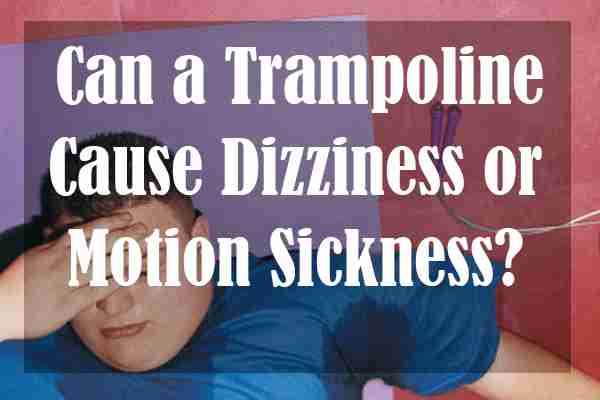
Can a Trampoline Cause Dizziness or Motion Sickness?
Have you ever experienced motion sickness or dizziness after jumping on your trampoline and worried that it was just all in your head? Well, don't worry, you’re probably not the only one. Dizziness and motion sickness are actually quite common on a trampoline.
Is your favorite activity causing you distress?

Jumping on a trampoline is without a doubt one of the most fun recreational activities we can think of. Kids love them, grown-ups love them, and chances are your grandma wishes she could take a few bounces.
The number of tricks that can be performed on a trampoline is countless, and you can even invite your friends to join in the fun. But is it all so perfect?
I’ve been wondering for quite some time why I seem to be getting strange reactions after jumping on my trampoline for a few minutes. At first, it seemed as if I was experiencing a migraine, or something similar. Needless to say, I quickly brushed it off as a one-time thing.
However, when I went out to play on it with my kids a few days later, the same thing happened again. Now, the thing about me is that I never let a little thing like dizziness get in the way of me having fun. So I continued bouncing. That was a rookie mistake.
As soon as I got off the trampoline, the dizziness got worse than ever. What’s more, I was feeling a bit queasy as well. That’s when I decided to further look into it.
Is trampoline dizziness a real thing?

Unfortunately, it is. Just by looking at all the trampoline forums out there, you can easily see that plenty of people experience dizziness after bouncing on a trampoline. However, you’ll be delighted to know that there is a way to reduce the symptoms.
Step #1: Stop bouncing for a while
The first thing you can do is to get up on your trampoline and start bouncing slowly. If you’re not feeling dizzy, then bounce a bit higher, and see what happens. The key here is to pinpoint the exact moment when you start to feel even a bit dizzy and stop bouncing immediately.
Step #2: Take some deep breaths
Get off the trampoline, calm yourself with some deep breaths and relax. Walk around for a bit, and only when your head is completely clear, you can continue bouncing up until the point where you first felt dizzy.
Step #3: Don’t bounce too high
It’s important to recognize how high you can bounce without a wave of dizziness sweeping over you. Don’t be disappointed if you can’t bounce as high as you’d like to. The main thing is that you don’t have to completely give it up.
Moreover, if you do this step every day, you’ll increase your threshold and will probably be able to bounce higher after a while.
What about trampoline motion sickness?

Although dizziness is also a symptom of motion sickness, there are some others that manifest as well. These include nausea, vomiting, and headache. If you feel any of them while you’re bouncing on your trampoline, you should stop immediately.
Trampoline motion sickness is quite common, but just like with dizziness, you can reduce the symptoms.
Basically, you should do the exact same thing as you would do if you felt dizzy: stop bouncing, and take some deep breaths to recover.
Furthermore, if you feel you’re starting to have a headache, you should also do the following steps:
- 1. Put both your hands on the side of your head.
- 2. Place your thumbs under your ears, and your fingers behind your head.
- 3. Squeeze your fingers and thumb together.
- 4. Hold that position for 45 seconds.
- 5. After 45 seconds, lower your head towards the ground, as if you’re looking at your feet.
- 6. Slowly ease the pressure, but keep your head down for 30 more seconds.
- 7. After that, reposition your fingers to the base of your skull, and keep your thumbs under your ears.
For the best results, you should do this exercise before and after bouncing on your trampoline.
Another thing that can help with motion sickness is to relax. It may sound silly, but you’re probably a lot tenser than you think, especially since you expect to feel sick. Just relax, and enjoy yourself!
The conclusion
Overall, you should be glad to know that trampoline dizziness is a real thing, and that plenty of people have, and will experience it, so you’re not alone. The same goes for trampoline motion sickness.
On the bright side, there is a way to reduce the symptoms of these side-effects, so you won’t have to give up your favorite activity.
If you’ve experienced one or both of them, please leave a comment below. Also, share this post so other people can also find out how to reduce the symptoms and continue enjoying a good trampoline bounce!

